The White House Came Shopping
 WILLIAM G. ALLMAN
WILLIAM G. ALLMAN
by the middle of the nineteenth century, New York City was wellestablished as the most populous city in the United States, with a powerful industrial and mercantile identity, producing or importing goods lauded as the newest and most stylish. In 1845, the White House came shopping at the manufacturers, merchants, and department stores that are credited with soon influencing the display of manufactured goods at the 1853 New York “Crystal Palace,” the first U.S. world’s fair, visited by President Franklin Pierce. The White House has been patronizing New York City ever since.1
53 white house history quarterly
OPPOSITE: ALAMY / TOP: NEW-YORK HISTORICAL SOCIETY
left
THE EARLIEST FURNISHINGS
the decorative arts that furnished the white house when it was first occupied in 1800 may have included items acquired for the initial presidential residences in New York City in 1789–90, if any of those furnishings had been moved to Philadelphia in 1790 and then on to the new permanent capital of Washington. Such New York City objects would, however, have been lost in the burning of the White House by the British in 1814. There is no evidence that either Thomas Jefferson or James and Dolley Madison shopped in New York in those pre-fire years, the heyday of such masterful cabinetmakers as Duncan Phyfe and Charles-Honoré Lannuier, now both featured in the White House Collection. With President James Monroe buying furnishings in Paris in 1817 and Andrew Jackson in Philadelphia in the 1830s, it was not until 1845 that the merchants and manufacturers of New York City became influential in the decorative arts of the White House.
The decorative arts that furnished the White House when it was first occupied in 1800 may have included items acquired for the initial presidential residences in New York City in 1789–90, if any of those furnishings had been moved to Philadelphia in 1790 and then on to the new permanent capital of Washington. Such New York City objects would, however, have been lost in the burning of the White House by the British in 1814. There is no evidence that either Thomas Jefferson or James and Dolley Madison shopped in New York in those pre-fire years, the heyday of such masterful cabinetmakers as Duncan Phyfe and Charles-Honoré Lannuier, now both featured in the White House Collection. With President James Monroe buying furnishings in Paris in 1817 and Andrew Jackson in Philadelphia in the 1830s, it was not until 1845 that the merchants and manufacturers of New York City became influential in the decorative arts of the White House.
George Washington occupied two houses in
New York City as the first president of the United States. His second, larger house on Broadway had been occupied by the recently recalled French minister to the United States, Elénor FrançoisElie, the Comte de Moustier, and Washington purchased many of his French furnishings. These included a large dinner service of gilt-edged white porcelain, much of which the Comte de Moustier had purchased circa 1788 from the Royal Porcelain Manufactory of Sèvres. Washington used the French china in the subsequent presidential house in Philadelphia, but as it was his personal property, he took it home at the end of his presidency in 1797. In 1919, shortly after First Lady Edith Wilson installed the White House China Collection in its current location in the China Room on the Ground Floor of the White House, a Sèvres sauce boat from the Moustier-Washington set was donated to the collection by Martha Washington’s great-greatgreat-granddaughter, thus bringing to the White House a decorative arts link with one of its New York predecessors.2
by the minister to the United States, Élénore-Françoisit home in 1919, Wilson its the the donated a New predecessors.
This Sèvres sauce boat (saucière), used by President George Washington at his second presidential house in New York and later donated to the White House Collection serves as a decorative arts link from the White House to New York.
This Sèvres sauce boat (saucière), used by President George Washington at his second presidential house in New York, and later donated to the White House Collection, serves as a decorative arts link from White House to New York.

previous spread left
sauce boat (saucière), President George house in New York and Collection serves as decorative the White features Furniture— M. & H.
previous spread left
The cover of the October 9, 1880, Scienti c American features an illustration entitled “The Manufacture of Parlor Furniture— Factory of M. & H. Schrenkeisen, New York City.”
The cover of the October 9, 1880, Scienti c American features an illustration entitled “The Manufacture of Parlor Furniture— Factory of M. & H. Schrenkeisen, New York City.”
A six story building at 23–29 Elizabeth Street, the Schrenkeisen factory housed one of the many furniture makers in New York at the time.
A six story building at 23–29 Elizabeth Street, the Schrenkeisen factory housed one of the many furniture makers in New York at the time.
previous spread right
six story makers York at and four of on Society
previous spread right
A mahogany and pine tool chest made by New York cabinetmaker Duncan Phyfe in c. 1790 houses more than four hundred of his tools. The chest, which descended in his family to his great-grandsons, has been on loan to the New-York Historical Society since 1927.
A mahogany and pine tool chest made by New York cabinetmaker Duncan Phyfe in c. 1790 houses more than four hundred of his tools. The chest, which descended in his family to his great-grandsons, has been on loan to the New-York Historical Society since 1927.
54
BRUCE WHITE FOR THE WHITE HOUSE HISTORICAL ASSOCIATION white house history quarterly
BRUCE WHITE FOR THE WHITE HOUSE HISTORICAL ASSOCIATION
top
heart-back chairs acquired for the White House during the presidency of James K. Polk are seen in use during the presidency of Ulysses S. Grant at a State Dinner for the Joint High Commissioners, March 9, 1871. Made of rosewood by the New York furniture maker Charles A. Baudouine, the chairs were upholstered in purple.
A set of heartbacked chairs acquired for the White House during the presidency of James K. Polk are seen in use during the presidency of Ulysses S. Grant at a State Dinner for the Joint High Commissioners, March 9, 1871. Made of rosewood by the New York furniture maker Charles A. Baudouine, the chairs were upholstered in purple.

One of seventeen of the forty-two heart-back chairs remaining in the White House Collection today.
right
One of seventeen of the forty-two heart-back chairs remaining in the White House Collection today.

HERTS BROTHERS
CHARLES A. BAUDOUINE DANIEL G. HATCH & COMPANY
In 1845, President and Mrs. James K. Polk called on Washington banker and art collector William Wilson Corcoran to be their agent for the funds allocated to a new president for the Executive Mansion. Corcoran looked to New York manufacturers and merchants to complete the task. In one example, in September 1845, furniture maker Charles A. Baudouine provided “42 Rosewood chairs in plush”2 for the State Dining Room; the upholstery was purple, as described by Elizabeth Dixon, wife of a Connecticut congressman.3 At that time, the room seated only thirty to forty guests at straight or H-shaped tables. A photograph of the Polk cabinet, taken in the State Dining Room in 1846—the first known photograph of a White House interior— shows the president seated in what appears to be one of these heart-shaped-back chairs. Although a new set of State Dining Room chairs from New York manufacturer Herts Brothers was acquired in 1882 during the Chester Arthur administration, none of that later enlarged set survived continuously in the White House, although one was reacquired the
In 1845, President and Mrs. James K. Polk called on Washington banker and art collector William Wilson Corcoran to be their agent for the funds allocated to a new president for the Executive Mansion. Corcoran looked to New York manufacturers and merchants to complete the task. In one example, in September 1845, furniture maker Charles A. Baudouine provided “42 Rosewood chairs in plush” for the State Dining Room; the upholstery was purple, as described by Elizabeth Dixon, wife of a Connecticut congressman.3 At that time, the dining room seated only thirty to forty guests at straight or H-shaped tables. A photograph of the Polk cabinet, taken in the State Dining Room in 1846—the first known photograph of a White House interior—shows the president seated in what appears to be one of these heart-shaped-back chairs. Although a new set of State Dining Room chairs from New York manufacturer Daniel G. Hatch & Company was acquired in 1883 during the Chester Arthur administration, none of that later enlarged set survived continuously in the White House, although one was reacquired in 1972. Seventeen of the graceful 1845 chairs, however, proved useful in the Private Quarters and remain in the collection.
55 TOP: LIBRARY OF CONGRESS / RIGHT: BRUCE WHITE FOR THE WHITE HOUSE HISTORICAL ASSOCIATION white house history quarterly
TOP: LIBRARY OF CONGRESS / RIGHT: BRUCE WHITE FOR THE WHITE HOUSE HISTORICAL ASSOCIATION
right
E. V. HAUGHWOUT & DAILEY
On July 14, 1853, President Franklin Pierce took part in the opening of the nation’s first world’s fair in New York City. Held in a “Crystal Palace” inspired by the London exposition of 1851, this “Exhibition of the Industries of All the Nations” placed special emphasis on American progress in science, art, and industry. In reporting on the fair, Horace Greeley, publisher of the NewYork Tribune, cited the 1852 partnership of Eder Vreeland Haughwout & William I. F. Dailey as having “established the art of decorating in this city” as demonstrated by a “very fine collection of decorated Porcelain.” 4 Another publication was not so kind: “The designs are chiefly copies from works executed abroad, and present therefore no point worthy of particular remark. Two plates with the cypher of the President and the arms of the United States form part of a service for the use
of that functionary.”4An accompanying engraving (printed in reverse) shows plates of two patterns on which the enterprising Haughwout would nonetheless capitalize. While still in New York, the president ordered a 355-piece State Service, without the personalizing “P” initial suggested for the central shield decoration. The only piece to remain in the White House since 1853 is the “Centre Piece,” a tall stand ornamented with three female figures in unglazed porcelain. Similar figures on a basket purchased by Queen Victoria at the London Crystal Palace were described as representing Love, Peace, and Abundance. When retrieved from the White House attic by new First Lady Caroline Harrison in 1889, this centerpiece was attributed to Dolley Madison, but it has long been correctly identified as being from the service sold to President Pierce in New York.
far left
Decorated by Haughwout and Dailey for President Franklin Pierce in 1853, this porcelain centerpiece features three figures representing Love, Peace, and Abundance.

near left
Included in the 666-piece State Service purchased by First Lady Mary Todd Lincoln on an 1861 shopping trip to E. V. Haughwout & Company in New York, this dinner plate is decorated in her favorite “solferino” purple and embellished with the U. S. Coat of Arms.
Decorated features three gures and purchased First Lady Mary Todd Lincoln on an 1861 shopping trip to E. V. Haughwout & Company in New York, this dinner plate is decorated in her favorite “solferino” purple and embellished with the U. S. Coat of Arms.
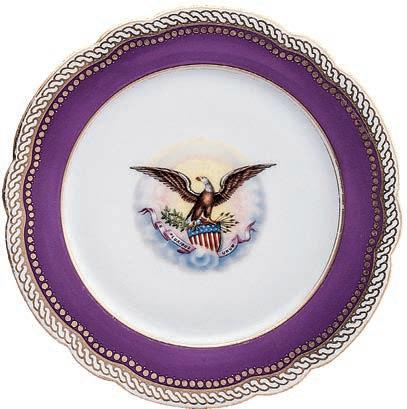
Coat
cost $3,195; the Johnson reorder of cost $2,061.6
Eight years later when First Lady Mary Todd Lincoln traveled to New York to shop, she visited the successor firm E. V. Haughwout & Company (at 488–92 Broadway, an extant building) and ordered a State Service based on the second of the plates illustrated in 1853. The U.S. Coat of Arms and Moorish tracery edge were retained, but the originally proposed blue decoration was changed to a purplish-red color called “solferino,” perhaps not so well known today as the color “magenta,” both named by the French for 1859 battles. In January 1866, the Andrew Johnson White House called on Haughwout to “replace the pieces broken and lost of the Solferine sett.” The 1861 order of 666 pieces had cost $3,195, the Johnson reorder of 343 pieces $2,061.5
56 white house history quarterly
New-
Tribune the
accompanying (printed in
Eight years later when First Lady Mary
the Haviland & Company porcelain dinner service purchased by President and Mrs. Rutherford
B. Hayes for the White House in 1880 feature ora and fauna designs based on watercolors by Theodore R. Davis.
HAVILAND & COMPANY
Haviland & Company, the well-known French porcelain maker that provided some of the blanks for the Lincoln china was actually founded by a New Yorker, importer David Haviland. He moved to Limoges in 1842 to produce French ware decorated to the American taste and by 1853 had become the largest supplier to the United States. In 1872, through Washington, D.C., retailer J. W. Boteler & Brother, President and Mrs. Ulysses S. Grant ordered supplemental pieces for the Lincoln service from Haviland as well as a formal State Dinner service. Marked pieces from both purchases remain in the collection.
Haviland & Company, the well-known French porcelain maker that provided some of the blanks for the Lincoln china, was actually founded by a New Yorker, importer David Haviland. He moved to Limoges in 1842 to produce French ware decorated to the American taste and by 1853 had become the largest supplier to the United States. In 1872, through Washington, D.C., retailer J. W. Boteler & Brother, President and Mrs. Ulysses S. Grant ordered supplemental pieces for the Lincoln service from Haviland as well as a formal State Dinner service. Marked pieces from both purchases remain in the collection.

Haviland also produced the amazing Rutherford B. Hayes State Service. In 1879, after the firm had provided an initial quote, First Lady Lucy Webb
Weekly, in the White House
decorated with native flora and fauna. With Mrs. Hayes’s approval, Davis went into seaside seclusion at Asbury Park, New Jersey, to create designs that included new forms and twelve different images for each of five types of plates. After contract negotiations, Haviland delivered the elaborate service in June and December 1880. To recoup some of the cost, the manufacturer was permitted to sell the designs to the public, with those pieces bearing an 1880 patent mark rather than the red, white, and blue “TD 1879” monogram found on the official service.
Hayes happened to meet Theodore R. Davis, artist and reporter for the New York–based publication Harper’s Weekly, in the White House Conservatory. They discussed the new china, and Davis suggested that a uniquely American service could be created if decorated with the native flora and fauna. With Mrs. Hayes’s approval, Davis went into seaside seclusion at Asbury Park, New Jersey, to create designs that included new forms and twelve different images for each of five types of plates. After contract negotiations, Haviland delivered the elaborate service in June and December 1880. To recoup some of the cost, the manufacturer was permitted to sell the designs to the public, with those pieces bearing an 1880 patent mark rather than the red, white, and blue “TD 1879” monogram found on the official service.
57 white house history quarterly ALL PHOTOGRAPHS THIS SPREAD: BRUCE WHITE FOR THE WHITE HOUSE HISTORICAL ASSOCIATION
right
ALL PHOTOGRAPHS THIS SPREAD: BRUCE WHITE FOR THE WHITE HOUSE HISTORICAL ASSOCIATION
Examples from the Haviland & Co. porcelain dinner service purchased by President and Mrs. Rutherford B. Hayes for the White House in 1880 feature flora and fauna designs based on watercolors by Theodore R. Davis.
initial
POTTIER & STYMUS MANUFACTORING COMPANY
The Grants also patronized two highly fashionable New York furniture and design firms. In 1869, the cabinet room on the Second Floor (the room to the west of the Lincoln cabinet room) was entrusted to Pottier & Stymus Manufacturing Company (founded in 1859 by Auguste Pottier and William P. Stymus Sr., with a showroom at 623 Broadway). Furnishings included a conference table, chairs, sofa, desk, overmantel mirror, and window cornices, all in dark-finished wood, as well as a white marble mantel and a chandelier and sconces. Remaining in the collection are the table, sofa, three armchairs, and a revolving desk chair. The table has
become known as the “Treaty Table”; it was used when the Spanish-American Peace Protocol was signed in the cabinet room in 1898, but it has also been used for such treaty signings as the
Included in the furnishings purchased from the New York firm Pottier & Stymus Manufacturing Company by President and Mrs. Grant for the White House are the conference table (left) and the arm chairs (below), which remain in the White House Collection today. The table with eight lockable drawers has come to be known as the Treaty Table for the many peace treaties and agreements that have been signed on it.

Included in the the New York rm Manufacturing Company by Mrs. Grant for are the conference table (left) and the armchairs (below), drawers Table agreements been signed on it.

Peace Accord on the South Lawn in 1993.
Kellogg-Briand Peace Pact in the East Room in 1929 and the Israel-Palestine Peace Accord on the South Lawn in 1993.6
58 ALL PHOTOGRAPHS THIS SPREAD: BRUCE WHITE FOR THE WHITE HOUSE HISTORICAL ASSOCIATION white house history quarterly
ALL PHOTOGRAPHS THIS SPREAD: BRUCE WHITE FOR THE WHITE HOUSE HISTORICAL ASSOCIATION a
Grants the Brothers rm Red from fourteenpiece remain Collection (right) and a center
In 1875, the Grants hired the Herter Brothers firm to furnish and decorate the Red Room. Two items from the fourteen piece suite remain in the White House Collection today, a gilded lady’s chair (right) and a center table (below).
HERTER BROTHERS
In 1875, the prominent Herter Brothers firm, which had provided bedroom furniture in 1872, was hired by the Grants to redecorate the Red Room. Founded in 1864 by Gustave and Christian Herter, the company had become one of the first in the United States to provide a full range of decorative services with its own design, cabinetmaking, and upholstery workshops. The influence of Japanese arts in the decorative arts at that time was seen in some of the Red Room textiles specifically described as “Japanese”—draperies of satin damask and upholsteries of velvet and brocade. From a fourteen-piece suite of furniture, only two pieces—the labeled center table and one of a pair of gilded lady’s chairs— remain in the collection.7
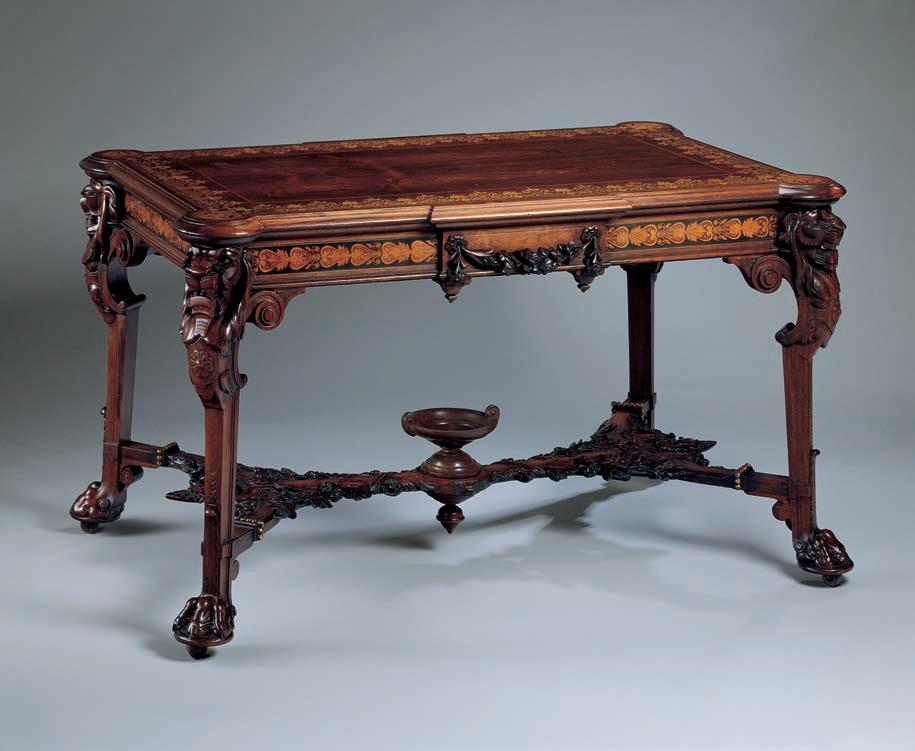
fur collection.
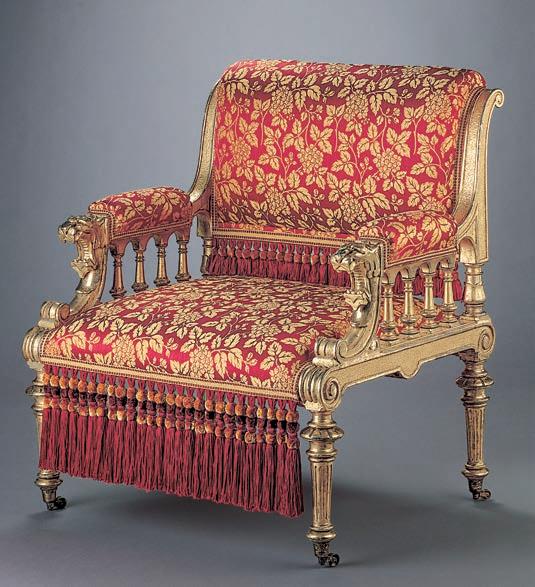
59 white house history quarterly
Ti any silver cup
TIFFANY & COMPANY
The name Tiffany has many connections to the decorative arts of the White House. In 1853, Charles Lewis Tiffany took control of an emporium of which he was a founding partner, shortening the name to Tiffany & Company and focusing on jewelry and luxury goods. In 1880 the firm provided photographs and drawings to First Lady Lucy Hayes, who selected two pairs of gilded brass candelabra, probably made in Europe, for the State Dining Room. The purchase coincided with the arrival of the new Hayes State Dinner Service. In 1898, the firm was commissioned to make an elaborate silver presentation cup to be presented by President William McKinley to the French ambassador Jules Cambon
luxury goods. In 1880 the firm provided photographs and drawings to First Lady Lucy Hayes, who selected two pairs of gilded brass candelabra, probably made in Europe, for the State Dining Room. The purchase coincided with the arrival of the new Hayes State Dinner Service. In 1898, the firm was commissioned to make an elaborate silver presentation cup to be given by President William McKinley to the French ambassador, Jules Cambon, “in token of his friendly
services in the negotiation of the Peace Protocol between the United States and Spain.”7 The protocol had been signed in the cabinet room on August 12, 1898, so, with this White House association, the three-handled cup, decorated with eagles and the seals of the United States, Spain, and France, was acquired for the collection in 1972 with donated funds.
“in token of his friendly services in the negotiation of the Peace Protocol between the United States and Spain.”7 The protocol had been signed in the cabinet room on August 12, 1898, so, with this White House association, the three-handled cup, decorated with eagles and the seals of the United States, Spain, and France, was acquired for the collection in 1972 with donated funds. In 1966, when Tiffany & Company was producing many of the state gifts presented by President Lyndon Johnson to visiting dignitaries, the firm was entrusted with designing the Johnson State Service and contracting for its production by Castleton China in Pennsylvania; the names of both firms appear on this service for 216, received as an
In 1966, when Tiffany & Company was producing many of the state gifts presented by President Lyndon Johnson to visiting dignitaries, the firm was entrusted with designing the Johnson State Service and contracting for its production by Castleton China in Pennsylvania; the names of both firms appear on this service for 216, received as an anonymous

60 white house history quarterly
Made by Tiffany & Company in 1899, this silver presentation cup was commissioned by President William McKinley for the French ambassador in recognition of his role in the peace negotiations that ended the SpanishAmerican War.
William McKinley in recognition in that Spanish-
rug for the Green Room .
donation, the first service not purchased with appropriated funds.
anonymous donation, the first service not purchased with appropriated funds.
In 1882, the fashionable Chester A. Arthur commissioned extensive decorative work in many of the State Rooms by Louis C. Tiffany & Company / Associated Artists, a brief partnership (1879–83) featuring Charles Tiffany’s son. Surviving elements from the Tiffany work include andirons and a fender from the Blue Room, porcelain vases from the Green Room and Red Room, and some table silver from Tiffany & Company, of which Louis would become design director in 1902. In 1927, Tiffany Studios provided First Lady Grace Coolidge with custom-made Aubusson-style rugs for the Green Room and Red Room, each featuring the Presidential Coat of Arms. These nearly one-hundred-year-old rugs remain in the collection; a design drawing for each was acquired in 1995 as gifts of the White House Historical Association.8
In 1882, the fashionable Chester A. Arthur commissioned extensive decorative work in many of the State Rooms from Louis C. Tiffany & Company / Associated Artists, a brief partnership (1879–83) featuring Charles Tiffany’s son (see the account beginning page 72 in this issue). Surviving elements from the Tiffany work include andirons and a fender from the Blue Room, porcelain vases from the Green Room and Red Room, and some table silver from Tiffany & Company, of which Louis would become design director in 1902. In 1927, Tiffany Studios provided First Lady Grace Coolidge with custom-made Aubusson-style rugs for the Green Room and Red Room, each featuring the Presidential Coat of Arms. These nearly one-hundred-year-old rugs remain in the collection; a design drawing for each was acquired in 1995 as gifts of the White House Historical Association.


61 white house history quarterly ALL PHOTOGRAPHS THIS SPREAD: BRUCE WHITE FOR THE WHITE HOUSE HISTORICAL ASSOCIATION above
Designed by Tiffany & Company and produced by Castleton China, the Lyndon Baines Johnson State Service for 216 features floral designs.
right
The design drawing made for a Green Room Aubussonstyle rug in 1926 by Tiffany Studios .
ALL PHOTOGRAPHS THIS SPREAD: BRUCE WHITE FOR THE WHITE HOUSE HISTORICAL ASSOCIATION
Ti any & produced Castleton China, for oral designs. design by Ti any Studios in 1926 for an Aubusson-style
MCKIM, MEAD AND WHITE
M C KIM, MEAD AND WHITE L. MARCOTTE & COMPANY
In 1902, President and Mrs. Theodore Roosevelt selected the renowned New York architectural firm of McKim, Mead and White for an extensive White House renovation, under the direction of partner Charles Follen McKim. This included structural and architectural changes to the public rooms on the State Floor and expansion of the Private Quarters with the removal of the presidential offices to a new West Wing. McKim selected the New York interior decorating firm L. Marcotte & Company (founded in 1849 by French brothers-in-law as Ringuet-LePrince & Marcotte, renamed in 1860 by Léon Marcotte, who died in 1887, and located at 298 Fifth Avenue since 1884) for the principal parlor, the Blue Room. The firm made the draperies and installed the dark blue wall cloth. It provided seat furniture, painted white with gold trim, consisting of a long sofa curved to fit the room’s oval shape and four matching armchairs—reminiscent of the seat furniture acquired for
In 1902, President and Mrs. Theodore Roosevelt selected the renowned New York architectural firm of McKim, Mead and White for an extensive White House renovation, under the direction of partner Charles Follen McKim. This included structural and architectural changes to the public rooms on the State Floor and expansion of the Private Quarters with the removal of the presidential offices to a new West Wing. McKim selected the New York interior decorating firm L. Marcotte & Company (founded in 1849 by French brothers-in-law as Ringuet-LePrince & Marcotte, renamed in 1860 by Léon Marcotte, who died in 1887, and located at 298 Fifth Avenue since 1884) for the principal parlor, the Blue Room. The firm made the draperies and installed the dark blue wall cloth. It provided seat furniture, painted white with gold trim, consisting of a long sofa curved to fit the room’s oval shape and four matching armchairs—reminiscent of the seat furniture acquired for the room by the Monroes in 1817—and ten English
Hepplewhite–style shield-back side chairs. Marcotte also provided Louis XVI–style gilded console tables, benches, and window cornices for the East Room; the cornices and some of the benches remain in that room today.10

the room by the Monroes in 1817—and ten English Hepplewhite–style shield-back side chairs. Marcotte benches, and window cornices for the East Room; today.
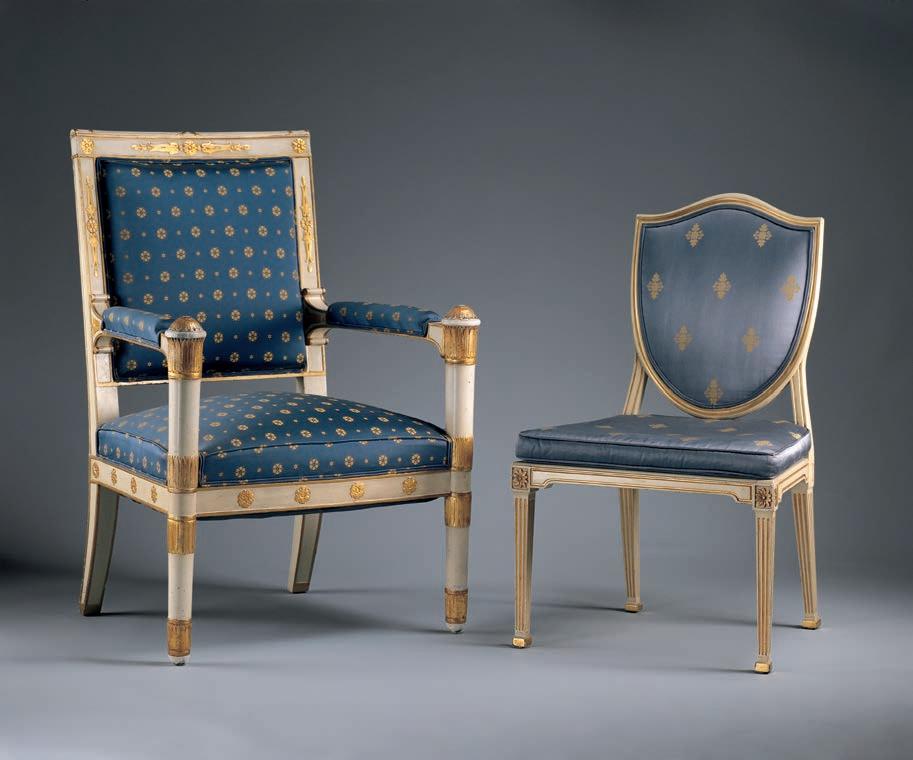
62 white house history quarterly
left An armchair and sidechair made for the Blue Room in 1902 by L. Marcotte & Company.
below
One of a group of carved and gilded benches made for the East Room by L. Marcotte & Company.
1902 & group &
xtures
Edward Caldwell & House Bohemian chandeliers (above) and made
Included in the collection of electric lighting fixtures made by Edward F. Caldwell & Company for the White House in 1902 are one of three Bohemian glass chandeliers (above) and one of four light standards made for the East Room.


EDWARD F. CALDWELL & CO.
McKim also patronized the New York firm of Edward F. Caldwell & Company (founded in 1895 by Caldwell and designer Victor von Lossberg, with its 1901 foundry, offices, and showroom at 36–40 West Fifteenth Street) for the manufacturing and installation of electrical lighting fixtures throughout the Residence and the new West Wing. Fixtures still in use include the chandeliers (shortened in 1952) and light standards in the East Room, the standards in the Entrance and Cross Halls (modified in 1961), and the silver-plated chandelier and sconces in the State Dining Room (gilded in 1961).11
1961).
63 white house history quarterly ALL PHOTOGRAPHS THIS SPREAD: BRUCE WHITE FOR THE WHITE HOUSE HISTORICAL ASSOCIATION
ALL PHOTOGRAPHS THIS SPREAD: BRUCE WHITE FOR THE WHITE HOUSE HISTORICAL ASSOCIATION
COMPANY
STEINWAY & SONS
In 1902 Steinway & Sons (founded in Manhattan in 1853 by Heinrich E. Steinweg) was making pianos at a company town that son William had founded in what is now the Astoria neighborhood of Queens (One Steinway Place). Since 1897, the art case department had been led by Joseph Burr Tiffany, of the Tiffany & Company family. He is credited with converting a Roosevelt order for an upright into a magnificent grand piano, the company’s no. 100,000, which the firm gave to the White House on January 23, 1903. It was designed by Richard and Joseph Hunt, heirs to their famous architect father Richard Morris Hunt. Decoration of the case was entrusted to Thomas W. Dewing, who in 1898 was a founding member of the American Impressionist group known as The Ten American Painters. Dewing’s wife, Maria Oakey, who was also a fine artist and well versed in the decorative arts, probably had a hand in the decoration as well. The inside of the lid features the figure of America, shown in a dress of late eighteenth-century style, surrounded by the Nine Muses of the classical Greek arts. The sides of the gilded case feature the seals of the thirteen original states. The 1903 piano was replaced by another Steinway custom-designed grand piano, no. 300,000, presented by Theodore Steinway to President and Mrs. Franklin D. Roosevelt on December 10, 1938. Steinway and his staff collaborated with architect Eric Gugler, sculptor Albert Stewart, and artist Dunbar Beck, to create a mahogany case supported by carved and gilded eagle legs and decorated with five gilt scenes of American music and dance. Long located in the East Room, this, the current White House formal piano, is now located in the Entrance Hall.12
Stewart, and artist Dunbar Dyson Beck to create a mahogany case supported by carved and gilded eagle legs and decorated with five gilt scenes of American music and dance. Long located in the East Room, this, the current White House formal piano, is now located in the Entrance Hall.
B. ALTMAN & COMPANY
above
The gilded grand piano made for the White House in 1903 by Steinway and Sons.

left
gilded grand by and Sons, and presented in 1903. left
The Truman State Service was one of many purchases made for the White House through New York department store B. Altman.
of New York department store B.
In 1948, as the 150th anniversary of White House occupancy approached, an ongoing concern about the structure became an issue of safety, so President and Mrs. Harry S. Truman and their daughter Margaret moved into Blair House. In 1950, as the renovation of the structure’s interior was under way, Charles T. Haight, the director of the design department of New York department store, B. Altman & Company, began planning for the refurbishing, which was to include repairs to old furniture and the acquisition of some new furniture—principally for the Private Quarters—and wall coverings, draperies, and carpets throughout.13
The Truman State Service (Lenox China, 1951) was one of many purchases made for the White House through New York department store B. Altman.

64
TOP: BRUCE WHITE FOR THE WHITE HOUSE HISTORICAL ASSOCIATION BOTTOM: WHITE HOUSE HISTORICAL
white house history quarterly
ASSOCIATION
-
E. town
TOP: BRUCE WHITE FOR THE WHITE HOUSE HISTORICAL ASSOCIATION BOTTOM: WHITE HOUSE HISTORICAL ASSOCIATION
President and Mrs. Dwight Eisenhower accepted a gift of antique furnishings for the Diplomatic Reception Room from the National Society of Interior Designers in 1960. Chairs and tables were arranged on a custom-designed oval wool rug made by Edward Fields (the company founded in 1935, with its mill in Flushing). The border included emblems taken from the flags of the fifty states in
Interior Designers (NSID) in 1960. Chairs and tables were arranged on a custom-designed oval wool rug made by Edward Fields (the company founded in 1935, with its mill in Flushing, Queens). The border included emblems taken from the flags of the fifty

order of their admission to the Union. Fields provided successor rugs, with more elaborate designs but each with the use of historic state emblems—in 1971 as a gift of Fields and the NSID, in 1983 as a gift of the manufacturer. It also provided rugs for the Ground Floor Corridor, the Cross Hall, and Grand Staircase, as well as the first twentieth-century set of rugs for the East Room in 1995.14
states in order of their admission to the Union. Fields provided successor rugs, with more elaborate designs but each incorporating historic state emblems—in as a gift of Fields and the NSID, and in 1983 as a gift of the manufacturer. Fields also provided rugs for the Ground Floor Corridor, the Cross Hall, and Grand Staircase, as well as the first twentieth-century set of rugs for the East Room in 1995.
65 HISTORIC IMAGES white house history quarterly
Carpet maker Edward Fields and his son Jack examine a carpet made for the Diplomatic Reception Room in 1971.
EDWARD FIELDS
HISTORIC IMAGES
Fields Diplomatic Room
Made in New York
In 1845, President James K. Polk purchased a set of chairs for the State Dining Room from cabinetmaker Charles A. Baudouine. The Baudouine Building at 1181 Broadway was one of many properties owned by the successful artisan.
Above: Watercolor made by John Rubens Smith in 1816 depicts cabinetmaker Duncan Phyfe’s shop at 168–72 Fulton Street. Several pieces made by Phyfe were acquired for the White House during the Kennedy presidency.

Below: The marble building at Thirty-Seventh Street and Fifth Avenue served as Ti any & Company’s agship store from 1905 to 1940. Ti any supplied design services and furnishings to the White House for many presidencies.
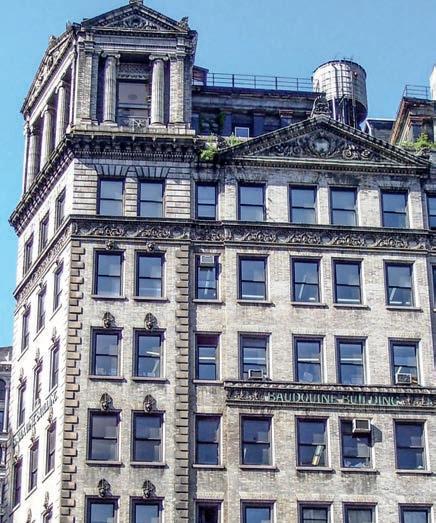
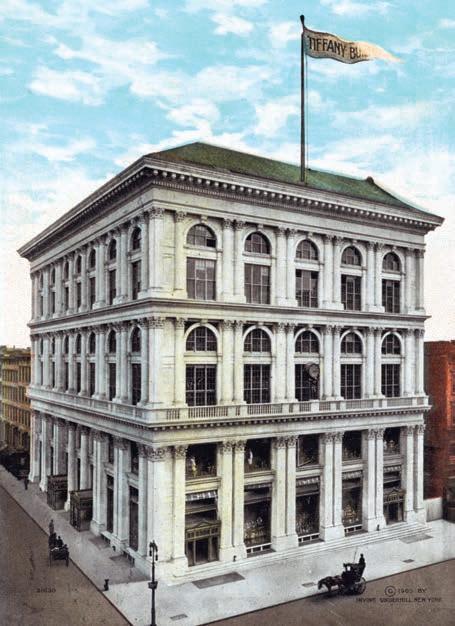
A view of Steinway & Sons’ factory and lumber yard in Astoria, Queens, 1882. Steinway piano no. 100,000 was made here for the White House in 1902 and presented in 1903.
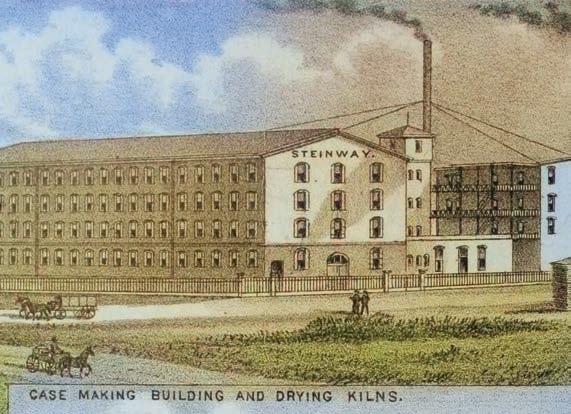
66 white house history quarterly
CLOCKWISE: BEYOND MY KEN, WIKIPEDIA / METROPOLITAN MUSEUM OF ART / MUSEUM OF THE CITY OF NEW YORK / ALMAY
Pictured here in an 1859 issue of the Illustrated London News, this building at 488–92 Broadway was built in 1857 to house E. V. Haughwout & Company, a luxury goods store. It was here that First Lady Mary Todd Lincoln ordered a State Dinner Service for the White House in 1861.

B. Altman and Company’s flagship department store at 355–71 Fifth Avenue is seen here c. 1914. Altman provided decorating services and furnishings for the newly renovated White House during the Truman presidency.

67 white house history quarterly
TOP: WHITE HOUSE HISTORICAL ASSOCIATION /
BOTTOM: WIKIMEDIA
KENNEDY ACQUISITIONS
KENNEDY ACQUISITIONS
In 1961, First Lady Jacqueline Kennedy almost immediately dove into a notable project to bring a greater sense of history to the interiors of the White House. With an advisory committee and a professional museum curator, she refurbished rooms and added antiques received by donation or acquired with donated funds. These acquisitions included a silver plateau made by New York City silversmith John W. Forbes, circa 1820–25. With plinths decorated with eagles, this mirror-floored table centerpiece was installed on the table in the old Family Dining Room as a rare American counterpart to the gilded bronze French plateau purchased in 1817 for President James Monroe that was exhibited next door in the State Dining Room.
Furniture included pieces by two of the foremost New York cabinetmakers of the early nineteenth
In 1961, First Lady Jacqueline Kennedy almost immediately dove into a notable project to bring a greater sense of history to the interiors of the White House. With an advisory committee and a professional museum curator, she refurbished rooms and added antiques received by donation or acquired with donated funds. These acquisitions included a silver plateau made by New York City silversmith John W. Forbes, circa 1820–25. With plinths decorated with eagles, this mirror-floored table centerpiece was installed on the table in the old Family Dining Room as a rare American counterpart to the gilded bronze French plateau purchased in 1817 for President James Monroe that was exhibited next door in the State Dining Room.
century—Duncan Phyfe and Charles-Honoré Lannuier. The popularity of the high-style product of the large Phyfe workshop has led many pieces once firmly attributed to Phyfe to be redesignated “in the manner or style of Phyfe.” Under Mrs. Kennedy, however, the White House received pieces with strong Phyfe provenances—for the Library on the Ground Floor a ten-piece suite of seat furniture consisting of settees and chairs in the Regency style, made circa 1810, and for the Ground Floor Corridor an early Grecian style pier table, made circa 1834. Other pieces with Phyfe attributions can be found in the Green Room, which was refurbished in 1972 with furniture by Phyfe or of the Phyfe style.
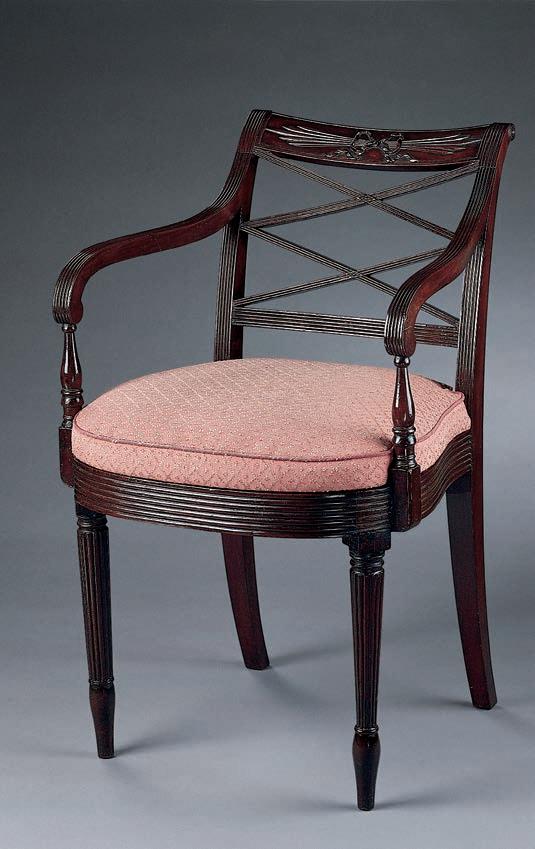

One of the earliest Kennedy acquisitions was a circular table (guéridon ) made by Lannuier, circa 1810. Bearing a paper label in English and French for “Honoré Lanniuer [sic] Cabinet Maker
Furniture included pieces by two of the foremost New York cabinetmakers of the early nineteenth century—Duncan Phyfe and Charles-Honoré Lannuier. The popularity of the high-style product of the large Phyfe workshop has led many pieces once firmly attributed to Phyfe to be redesignated “in the manner or style of Phyfe.” Under Mrs. Kennedy, however, the White House received pieces with strong Phyfe provenances—for the Library on the Ground Floor a ten-piece suite of seat furniture, including settees and chairs in the Regency style, made circa 1810, and for the Ground Floor Corridor an early Grecian style pier table, made circa 1834. Other pieces with Phyfe attributions can be found in the Green Room, which was refurbished in 1972 with furniture by Phyfe or of the Phyfe style.
68 white house history quarterly
A side chair (above left) armchair (above right), settee (opposite top), and pier table (opposite bottom) are among the pieces made by New York cabinetmaker Duncan Phyfe acquired for the White House during the Kennedy presidency.
A side chair (above left) and armchair (above right) are among the pieces made by New York cabinetmaker Duncan Phyfe that were acquired for the White House during the Kennedy presidency.
Acquired during the Kennedy administration, a silver plateau made by New York City silversmith

John W. Forbes is seen above in the Family Dining Room during the Clinton presidency. The detail at right highlights the neoclassical motifs that embellish the piece.
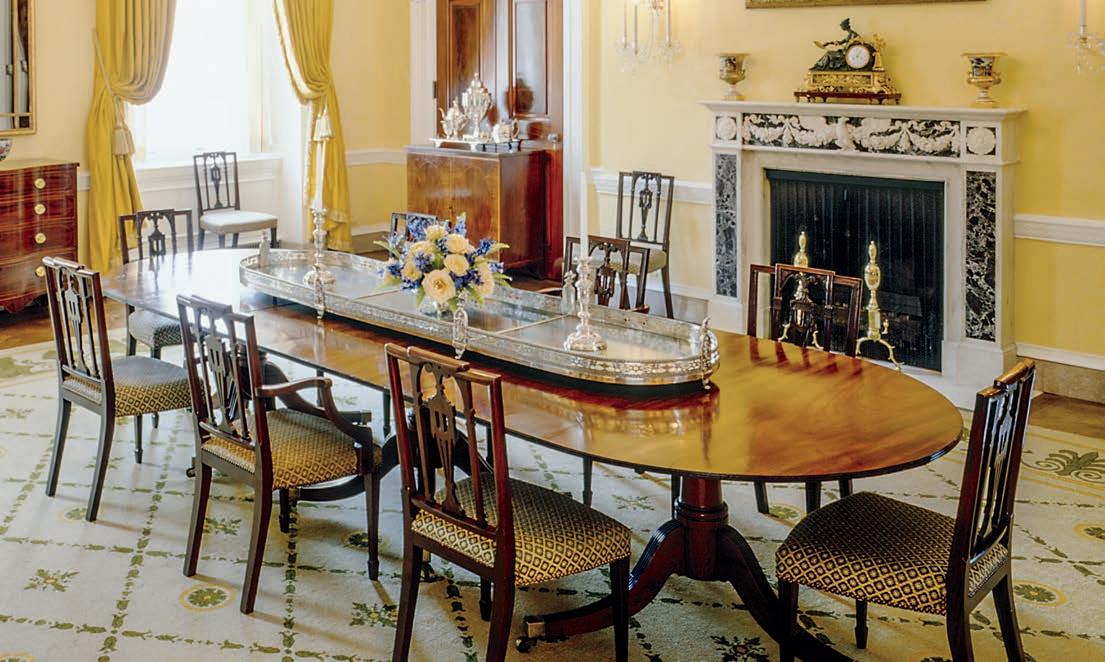
69 ALL PHOTOGRAPHS THIS SPREAD: BRUCE WHITE FOR THE WHITE HOUSE HISTORICAL ASSOCIATION white house history quarterly ALL PHOTOGRAPHS THIS SPREAD: BRUCE WHITE FOR THE WHITE HOUSE HISTORICAL ASSOCIATION
“The

70
1810. Bearing a paper label in English and French
great masterpiece of Lannuier’s amalgamated 1961, joined there by two additional Lannuierused in the Green Room, Blue Room, and Red
white house history quarterly BOTH PHOTOGRAPHS: BRUCE WHITE FOR THE WHITE HOUSE HISTORICAL ASSOCIATION
center table marked
misspelled paper label (above).
In 1819, while at the White House to paint a portrait of President James Monroe, the artist Samuel F. B. Morse commented that the rooms were furnished and decorated “in the most splendid manner; some think too much so, but I do not. Something of splendor is certainly proper about the Chief Magistrate for the credit of the nation.” For over 175 years, the manufacturers, designers,
mental in keeping the furnishings and décor of the
from the National Society of Interior Designers. Along with scenes of Boston, West Point, Niagara Falls, and the Natural Bridge of Virginia, the paper depicts, as seen across from Weehawken, New Jersey, what was called a “General View of New York.”
In 1819, while at the White House to paint a portrait of President James Monroe, the artist Samuel F. B. Morse commented that the rooms were furnished and decorated “in the most splendid manner; some think too much so, but I do not. Something of splendor is certainly proper about the Chief Magistrate for the credit of the nation.”9 For more than 175 years, the manufacturers, designers, and merchants of New York City have been instrumental in keeping the furnishings and decor of the White House up to Morse’s standard for the presidents, first families, and the nation.
notes
2. Official China, 12–13; Furnishing, 4–5, 340.
(from Paris),” it was lauded by Peter Kenny of the Metropolitan Museum of Art in his seminal book: “The great masterpiece of Lannuier’s amalgamated style is [this] superbly balanced and proportioned gueridon.”8 It has been in the Red Room since 1961, joined there by two additional Lannuier-labeled tables acquired in 1974 and 1993.
3. Furnishing, 84–85, 350; Diary of Elizabeth Dixon, December 1, 1845–February 10, 1847, Connecticut Historical Society Collection, quoted in Furnishing, 85, full text of diary entry in Official China, 65. Herts Brothers: Furnishing, 164, 359.
4. Haughwout & Dailey – Pierce State Service - Official China 72-75, Furnishing, 100-01, 352. Horace Greely, Art and Industry as Represented in the Exhibition at the Crystal Palace, New York, 1853–1854, Showing the Progress and State of the Various Useful and Esthetic Pursuits (New York: Redfield, 1853) quoted in Official China, 74. Professor Benjamin Silliman, Jr. and C.R. Goodrich, Esq., eds., The World of Science, Art and Industry Illustrated from Examples in the New York Exhibition 1853-1854 (New York: G.P. Putnam, 1854), 129, quoted in Official China, 74. E.V. Haughwout & Co. - Lincoln State Service - Official China, 78-86, Furnishing, 110-14, 354.
Principal sources are two White House Historical Association publications: Betty C. Monkman, William G. Allman, Lydia S. Tederick, and Melissa C. Naulin, Furnishing the White House: The Decorative Arts Collection (Washington, D.C.: White House Historical Association, 2023), and William G. Allman, O cial White House China from the 18th to the 21st Centuries 3rd ed. (Washington, D.C.: White House Historical Association, 2016). Quotations within these sources are separately cited.
1. Catherine Hoover Voorsanger and John K. Howat, eds., Art and the Empire City: New York, 1825–1861 (New York: Metropolitan Museum of Art, 2000), 42, 287.
2. National Archives, Miscellaneous Treasury Accounts of the General Accounting Office, 1790–1894, Record Group 217, acct. 93470, voucher 21.
5. Haviland & Co. – Grant State Service - Official China 90–96, Furnishing, 110–11, 114, 120–21, 354–55. Hayes State Service - Official China, 100–21, unnumbered insert following; Furnishing, 153–55, 357–58.
6. Furnishing, 136, 138-41, 356.
7. Furnishing, 141, 144–45, 355–56.
8. Hayes candelabra Furnishing, 152-53, 357; McKinley presentation cup - Furnishing, 186-87, 362;
9. Johnson State Service - Furnishing, 90-96, Furnishing, 276-77, 377; Arthur redecoration - Furnishing, 168, 169-173, 360-61; Tiffany Studios rugs – 224-25, 367.
10. Furnishing, 202–05, 364.
11. Caldwell & Co. - Furnishing, 206-07, 364.
Textiles for many of the public rooms in the Kennedy administration were secured from Scalamandré Silks (founded in 1929 by Franco Scalamandré and his wife Flora Barranzelli, to focus on re-creating fabrics used in historic houses and museums; for more than forty years its mill occupied an early twentieth-century industrial building at 37–24 Twenty-Fourth Street, Long Island City, now the remodeled “Silks Building”). Silks made by or acquired through the firm were used in the Green Room, Blue Room, and Red Room, and it would provide later generations of fabrics for those and other White House rooms.
3. Elizabeth L. C. Dixon, journal entry, December 19, 1845, “Journal Written During a Residence in Washington During the 29th Congress, Commencing with the First of December 1845,” Connecticut Historical Society Collection, Hartford, transcription by Caroline Welling Van Deusen, in White House History, no. 33 (Summer 2013): 48.
4. Horace Greely, Art and Industry as Represented in the Exhibition at the Crystal Palace, New York, 1853–1854, Showing the Progress and State of the Various Useful and Esthetic Pursuits (New York: Redfield, 1853), quoted in Allman, O cial White House China, 74.
5. Professor Benjamin Silliman Jr. and C. R. Goodrich, eds., The World of Science, Art and Industry Illustrated from Examples in the New York Exhibition, 1853–1854 (New York: G.P. Putnam, 1854), 129, quoted in Allman, O cial White House China, 74.
12. Furnishing, 212–13, 362; 1938 - Furnishing, 236-39, 369.
13. B. Altman & Co. - Furnishing, 237, 240-41, 369; Official China, 176-183.
14. Furnishing, 247, 298.
15. is this meant to be multiple endnotes? Kennedy Acquisitions –Forbes plateau - Furnishing, 56, 263, 346; Phyfe – 258-59, 269, 373, 376; Lannuier - Furnishing, 259-261, 374; Peter Kenny et al., Honoré Lannuier, Cabinetmaker from Paris (New York: Metropolitan Museum of Art, 1998), 76-77.
One Kennedy administration acquisition not made in New York, but depicting New York, is the scenic wallpaper entitled “Views of North America.” Made by Jean Zuber et Cie, Rixheim, France, circa 1834–36, this paper, removed from a house in Thurmont, Maryland, in 1961, was installed as a truly panoramic paper in the oval Diplomatic Reception Room in 1962 as an additional donation
6. National Archives, Miscellaneous Treasury Accounts of the General Accounting Office, 1790–1894, Record Group 217, acct. 14151, voucher 14, and acct. 15178, voucher 18; also see Allman, O cial White House China, 81, 86.
7. The inscription is quoted in Monkman et al., Furnishing the White House, 362.
8. Peter M. Kenny, Frances F. Bretter, and Ulrich Leben, Honoré Lannuier, Cabinet Maker from Paris: The Life and Work of a French Ébéniste in Federal New York (New York: Metropolitan Museum of Art, 1998), 75, quoted in Monkman et al., Furnishing the White House, 374.
9. Samuel F. B. Morris, journal entry, December 17, 1819, Samuel F. B. Morse: His Letters and Journals, ed. Edward Lind Morse (New York: Kennedy Galleries, 1973), 1:227.

71 white house history quarterly
-
-
Several ne pieces made by the French-born New York cabinetmaker Charles–Honoré Lannuier were acquired for the White House during the Kennedy administration, including this marble-topped center table (opposite) marked with Lannuier’s


 WILLIAM G. ALLMAN
WILLIAM G. ALLMAN































